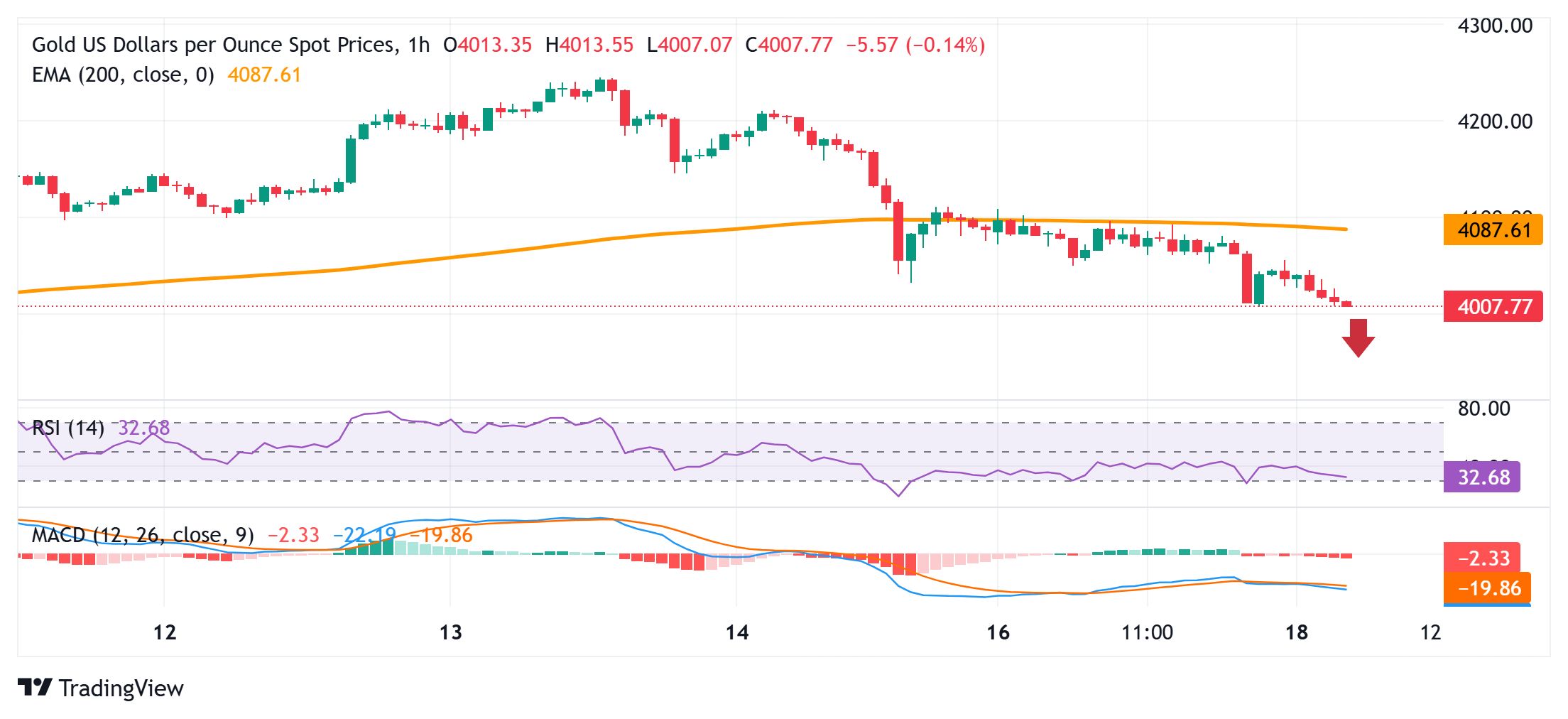
- Gold rebounds from sub-$4,000 levels, or an over one-week low, touched this Tuesday.
- Economic concerns weigh on the USD and benefits the commodity amid the risk-off mood.
- Reduced December Fed rate cut bets might keep a lid on further gains for the XAU/USD.
Gold (XAU/USD) shows some resilience below the $4,000 psychological mark and stages a modest recovery from a one-and-a-half-week low, touched during the early European session on Tuesday. Despite less dovish Federal Reserve (Fed) expectations, the US Dollar (USD) struggles to build on the previous day's gains amid concerns about the weakening economic momentum on the back of the longest-ever US government shutdown. This, along with a broadly weaker risk tone, turns out to be a key factor that offers some support to the safe-haven precious metal.
Meanwhile, a slew of influential FOMC members showed little conviction for reducing borrowing costs, forcing traders to pare their bets for another rate cut in December. This, in turn, could act as a tailwind for the Greenback and cap any meaningful appreciation for the non-yielding Gold. Traders might opt to wait for the FOMC Minutes and the delayed US Nonfarm Payrolls (NFP) report this week. This makes it prudent to wait for strong follow-through buying before confirming that the downfall witnessed over the past week or so has run its course.
Daily Digest Market Movers: Gold attracts some dip-buyers as safe-haven flow offsets reduced Fed rate cut bets
- The longest-ever US government shutdown led to an absence of official economic data and dampened expectations for another interest rate cut by the Federal Reserve in December. Moreover, several Fed officials recently signaled caution on further policy easing.
- Fed Vice Chair Philip Jefferson said on Monday that upside risks to inflation have declined somewhat and the current policy rate is somewhat restrictive. Jefferson, however, added that the central bank needs to proceed slowly as monetary policy approaches the neutral rate.
- According to the CME Group's FedWatch Tool, the probability for a 25 basis-point Fed rate cut in December has now fallen below 50%. This, in turn, has been a key factor that continues to drive flows away from the non-yielding Gold for the fourth consecutive day on Tuesday.
- Meanwhile, investors remain worried about the impact of the prolonged US government closure on the economy, which fails to assist the US Dollar in building on the previous day's gains. This might hold back the XAU/USD bears from placing aggressive bets and help limit losses.
- The reopening of the US government shifts the market focus back to the release of delayed economic data, including the key Nonfarm Payrolls (NFP) report on Thursday. Apart from this, the FOMC Minutes could offer cues about the rate-cut path and influence the commodity.
- Russia's Defence Ministry said that its forces have occupied strongholds in Orestopol in the Dnipropetrovsk region. Moreover, a Russian attack forced a Romanian border village to evacuate. This keeps geopolitical risks in play and could support the safe-haven precious metal.
Gold shows some resilience below the $4,000 pivotal point; not out of the woods yet

The XAU/USD pair recently failed to move back above the 200-hour Exponential Moving Average (EMA). The subsequent fall favors bearish traders and suggests that the path of least resistance for the Gold price is to the downside. Some follow-through selling below the $4,000 mark will reaffirm the negative bias and make the commodity vulnerable to accelerate the fall towards the $3,931 intermediate support en route to the $3,900 mark and late October swing low, around the $3,886 region.
On the flip side, any meaningful recovery attempt might now confront an immediate strong barrier near the $4,053-4,055 region. However, a sustained strength beyond could trigger a short-covering rally and lift the Gold price back to the 200-hour EMA, currently pegged just below the $4,100 round figure. Some follow-through buying will suggest that the recent slide witnessed over the past week or so, from the vicinity of mid-$4,200s, has run its course and pave the way for additional gains.
US Dollar Price Today
The table below shows the percentage change of US Dollar (USD) against listed major currencies today. US Dollar was the strongest against the Japanese Yen.
| USD | EUR | GBP | JPY | CAD | AUD | NZD | CHF | |
|---|---|---|---|---|---|---|---|---|
| USD | -0.04% | -0.05% | -0.02% | -0.07% | -0.06% | -0.20% | -0.16% | |
| EUR | 0.04% | -0.02% | 0.02% | -0.03% | -0.03% | -0.16% | -0.12% | |
| GBP | 0.05% | 0.02% | 0.04% | -0.02% | -0.02% | -0.14% | -0.11% | |
| JPY | 0.02% | -0.02% | -0.04% | -0.05% | -0.04% | -0.19% | -0.14% | |
| CAD | 0.07% | 0.03% | 0.02% | 0.05% | 0.00% | -0.12% | -0.09% | |
| AUD | 0.06% | 0.03% | 0.02% | 0.04% | -0.01% | -0.13% | -0.10% | |
| NZD | 0.20% | 0.16% | 0.14% | 0.19% | 0.12% | 0.13% | 0.03% | |
| CHF | 0.16% | 0.12% | 0.11% | 0.14% | 0.09% | 0.10% | -0.03% |
The heat map shows percentage changes of major currencies against each other. The base currency is picked from the left column, while the quote currency is picked from the top row. For example, if you pick the US Dollar from the left column and move along the horizontal line to the Japanese Yen, the percentage change displayed in the box will represent USD (base)/JPY (quote).








